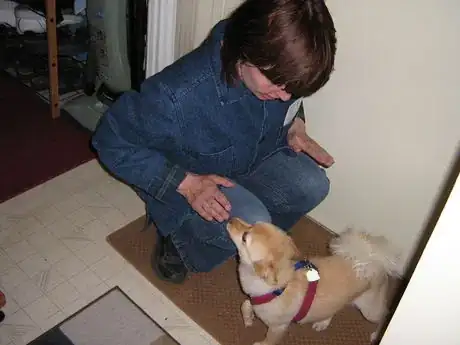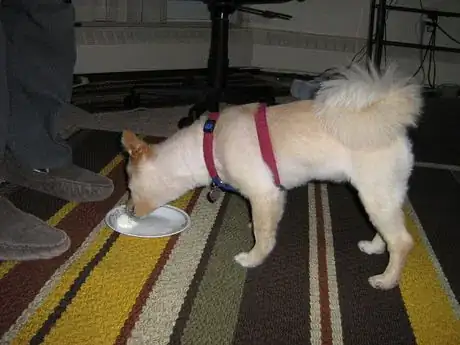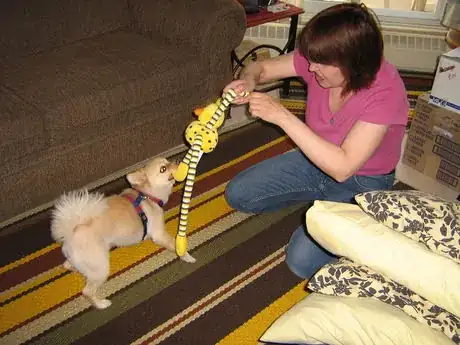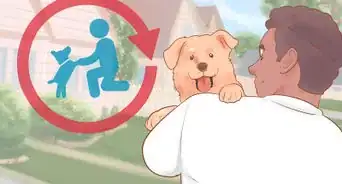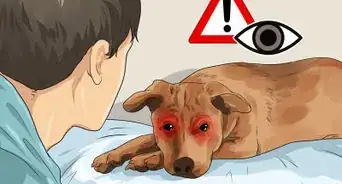wikiHow is a “wiki,” similar to Wikipedia, which means that many of our articles are co-written by multiple authors. To create this article, 9 people, some anonymous, worked to edit and improve it over time.
There are 11 references cited in this article, which can be found at the bottom of the page.
This article has been viewed 25,309 times.
Learn more...
Companionship with your pet can be one the most rewarding and satisfying parts of your life. This is especially true for people who live alone, at any stage in life. Regrettably, the circle of life is a reality that every pet parent must accept. To that end, making the most of the moments and years you share together will create heartfelt memories that last a lifetime.
Steps
Living Life to the Fullest
-
1Exercise! Dogs, both big and small, do not enjoy being cooped up inside the house or apartment all day. Besides being a great source of company, your dog can actually help keep you healthy because they need to be exercised. It is also a great bonding time.
- As your dog ages, regular exercise is important in keeping them from becoming obese, as well as preventing arthritis. Short, frequent walks are recommended in place of long walks, to keep your pet from tiring.
- A sign that your dog is getting too much exercise, or is over-exerting, can be observed by noting their respiration (counting the breaths your dog takes). A dog's respiration of should be between 25 to 35 breaths per minute when exercising. When respiration rises to over 35 breaths per minute, this means the dog is over-exerting his/herself. As your pet ages, and combined with any health issue, over-exercising can be detrimental to their health.
-
2Enjoy the mutual health benefits. It is suggested that as well as providing entertainment and companionship, dogs also provide many health benefits for their human companions.
- Pet owners who spend 15 to 30 minutes a day with their dog can benefit from a feeling peace and tranquility, as a result of the rise of associated chemical levels in the brain.
- Spending time with your pet can help to improve your mood and reduce depression in both men and women.[1]
Advertisement -
3Visit the vet annually. Every dog needs an annual checkup and vaccines. Using the the same veterinarian helps both your vet and dog to get to know each other. In addition, the vet will be able to give advice on caring for your pet as they age based on their history with your pet. Common age related ailments include:
- Eye problems, including vision loss
- Increased frequency of urination or strained urination
- Oral problems, including bad breath and bloody gums
- Skin problems, including the formation of lumps, moles, and bumps
- Arthritis and joint difficulties
- Weight loss or gain
- Behavioural issues and memory[2]
-
4Heed your vet's advice. Based on the annual examination, your vet may make suggestions regarding diet, dietary supplements, and exercise. Heeding this advice is important in order to ensure that your canine companion remains happy and healthy.
- Your vet knows how much you love your dog and the emotions that are involved when a pet enters their senior years. As a pet parent, never be afraid to ask your vet any questions you may have.
Loving Every Minute
-
1Age together; keep each other young. While adults age once every calendar year, our canine friends age seven years in that same period. A dog is considered to be a senior when he or she reaches the last 25% of their life expectancy.
- While the life expectancy varies by breed and size, generally giant dogs, such as Great Danes, St. Bernard's and breeds of Mastiffs, have a life expectancy of up to ten years. In the case of small breeds, including Beagles, Shih Tzu and Yorkshire Terriers, almost 40% reach an age in excess of ten years.[3]
- Your dog can aid in protecting your health: While you take care of your dog's health with annual trips to the vet, your pet has been found to aid in the health of their pet parent in other ways:
- Along with companionship and aiding in feelings of depression, dog owners have been noted to have lower cholesterol and blood pressure, as well as having a lower risk of heart attack.
- Some breeds are even able to detect cancer in their owners. This includes colon, bladder, lung, breast, ovarian, and skin cancer. Some dogs have been reported to have sniffed out a mole on the skin of there owner and bitten it off.[4]
-
2Have feeding time where your dog gets "people food". While the last thing that you want to have at the dinner table is a begging dog, single person households and busy family lifestyles can mean many meals sitting on the couch in the living room. Most pets have been taught that begging is a no no, but that is typically at the dinner table. Even well-trained dogs, while rarely attempting to look you in the eye, may sit in a spot that is within your reach, should you happen to want to share.
- For those of us who cannot resist the guilt, here is some people-food that is safe to share with your aging dog:
- Plain, low fat (or no fat) yogurt provides probiotics that can aid with any digestive issues.
- Cooked eggs are easily digested and do not carry any cholesterol issues. They can also be used to provide half of your dog's daily diet.
- Liver is packed with nutrients, vitamins and minerals. It can be used to make up to 5% of your pet's diet.
- Various types of fish are rich in Omega 3 fatty acids. These fatty acids contribute to a healthy coat and skin, along with supporting the immune system and reduce inflammation. The best sources are pink salmon, mackerel and and sardines.
- Skinless, dark "meat" of chicken provide more nutrition than the low fat white parts.
- Types of red meat, such as beef, provide nutrients including iron and zinc. To provide a wider variety of fatty acids, consider combining both red meat (beef and lamb) and poultry.
- In limited quantities, cooked cruciferous vegetables such as broccoli, cabbage, cauliflower and brussels sprouts, provide nutrients and antioxidants that prevent cancer. Note that cooking the above vegetables is important, as thyroid issues can result if eaten fresh or raw.
- Cooked sweet potatoes are rich in antioxidants, vitamin C and beta-carotene.
- Berries such as strawberries, blueberries, blackberries, and raspberries provide fiber, as well as potentially reducing the risk of cancer.
- Whole grains, including oatmeal, offer a variety of antioxidants, vitamins and minerals. They also adding fibre to your pet's diet.
- For those of us who cannot resist the guilt, here is some people-food that is safe to share with your aging dog:
-
3Have a feeding time for commercial dog food. When your dog enters his or her senior years, it is important that their diet consists an adequate amount of fat and protein, while ensuring it is lower in calories and higher in fibre.
- Take into consideration any health issues, such as heart, kidney or constipation issues, when deciding on senior pet food. These conditions will require a change in diet. Dogs prone to arthritic joints, especially in the cold of winter months, will benefit from a food supplement of glucosamine chondroitin. Dry dog food will help with tartar buildup on teeth if your dog is able to chew it.
- If your dog is still active, in good health and of appropriate weight, you can continue to feed your senior pet the same adult food as always. If activity level changes, you will want to keep an eye on their weight. Move to senior food if weight gain becomes an issue.[5]
-
Treating your dog: As your dog ages, their taste for particular treats may change. Also, with possible and/or impending medical conditions, treats including particular ingredients and supplements are advisable. You should also take your pet's size into consideration. Below are some suggestions for treats, based on the size and build of dogs:
- Large/giant dogs. Wedges of cooked potato, or a large jerky-type chew, is appropriate. It's also something that will take them a longer time to consume.
- Medium-sized dogs. One-ingredient treats, specially designed for digestion, such as freeze-dried liver bites, are a good choice. You can also look for treats that include pumpkin, sweet potato and probiotics, all of which are gentle on the stomach.
- Small/toy dogs. Soft, probiotic, cookies, with a filling of fruits and vegetables, help to keep the calorie count low and are easy on little jaws. You can also try filling the inside of a small, hollow toy with peanut butter, for a special treat.
-
4Share the love. The bond between pet and pet parent(s) is strong. When a pet owner is single, where the dog has one-on-one attention from their owner, it is especially strong. In family homes, your dog will always have a closer bond with one particular member; perhaps the one who spends the most time with them, feeds them, or exercises them.
- Pamper your pet. If your pet sleeps with you on your bed, consider building a ramp or a couple of steps in order to make climbing into bed easier. You should also provide pee pads.
- If you giving supplements for conditions related to aging, ensure that you are giving them to your dog on a consistent, regular basis.
- Puppy training pads are a good idea as your dog becomes a senior. Retraining them to the pee pad will save on middle of the trips outside, or a wet spot on the carpet when you wake up. Doggy diapers are also available if bladder control is a major health issue.
- Treats and snacks: As weight gain is a concern with senior dogs, ensure that you are giving age-appropriate treats, like those mentioned above. It should also be noted that treats should not be a major source of your dog's diet. Providing treats two to three times a day is ample; ten to 15 is going overboard. Also remember that, while the brightly colored treats made to resemble human food may look appealing, they are full of additives and artificial coloring. It is best to choose treats that are natural.
- Pamper your pet. If your pet sleeps with you on your bed, consider building a ramp or a couple of steps in order to make climbing into bed easier. You should also provide pee pads.
-
5Enjoy being loved. Dogs are loyal companions; they can be sweet, affectionate, protective, and loving to their owners. Every breed comes with their own personality and traits, but no matter the breed, your dog will always be loving and loyal to his/her master. There are five signs that your dog uses to show you their love:
- Meeting you at the door, wagging your tail, and being happy to see you.
- Looking at you with round and relaxed eyes. Studies have shown that this gaze between pet and pet parent can raise the mutual levels of the love hormone oxytocin in both the dog and the owner.
- Comes to you for cuddles, just because! They are looking for the attention without expecting something in return.
- Consistently wants to be near you. This does not mean that they want to be cuddling all of the time, but they want to be in the same vicinity. You might move to another room. When your dog notices, he/she will come to find out where you went, and curl up in a new spot close by.
- If your dog decides it is play time, he/she will bring a toy over to you as an invitation for fun.[6]
Laughing at the Silly Things
-
1Enjoy playtime. It is not just kids that want to have fun! Your pet wants to have fun too. Here are some suggestions to amuse both you and your dog: [7]
- Try out the canine version of 3-Card Monte. This is called Ante Up. To play it, take three paper cups and poke a hole in the bottom of each. Place the cups in front of your dog, having hidden a treat under one, then ask: "Where's the treat?". This is a great game, especially for pets that have mobility issues.
- Let your hunter find the prize with Finders Keepers. Secretly (okay, not too secretly) hide a small amount of treats in locations around your home. When the treasure is hidden, tell your dog to "find the treats"!
- Tug-of-War is always fun for any dog, regardless of the size or age. You do have to consider any infirmities or health issues your pet has, including loose or missing teeth or a weaker jaw.
- Playing Fetch is another of those timeless activities. Again, it is important to take your pet's health into consideration. While it will help to keep your dog's weight under control, keep in mind conditions like arthritis. Ensure that your do not overdo it. Maybe cut it down to five throws, instead of the 10 or 15 from a few years ago!
- Taking your dog swimming is wonderful fun. It is a low impact, aerobic workout that is easy on the joints, as well as working muscles and ligaments. Just like water aerobics is a great workout for us, it provides the same benefits for our pets. Plus, watching your pooch do the dog-paddle is so fun to watch.
- For those who do not have a place to take dogs swimming, small or toy dogs can go for a swim in the bathtub. You may also use a rigid (polyethylene) swimming pool! Pet stores often carry them in the spring and summer seasons.
-
2Take delight in antics. Our four legged friends are a wonderful source of amusement.
- Sometimes dogs react to the TV. Have you ever wondered if your dog can watch television? The answer is yes and they actually can have favourite shows too! Here are some factors can that draw your pet's attention to the TV:[8]
- Your dog may commence barking the split second he or she sees an animal on the television. They become territorial, barking at the perceived threat as vehemently as they would if the animal was standing in the same room. They become protective of their home and family!
- Dogs become familiar with particular shows or commercials. For some, just a few bars of a theme song or the melody of a bark-able commercial can be enough to send them into a tail spin.
- Taking a dog on a play-date can be particularly amusing. There can be multiple dogs sleeping in a recreation room where a TV is on. It takes just one to spy a dog on the TV to turn quiet time into a ruckus of barking. It is as if they take turns patrolling, a nonverbal pact to wake the others in the event of an intrusion!
- Sometimes dogs react to the TV. Have you ever wondered if your dog can watch television? The answer is yes and they actually can have favourite shows too! Here are some factors can that draw your pet's attention to the TV:[8]
Enjoying Every Moment
-
1Build memories. Take your pal to smell the flowers in the spring! Soak up the summer sunshine! Play together in the fallen leaves and watch your dog prance and frolic in the snow! Commemorate the special times with pictures and home movies through the wonders of modern technology.
-
2Celebrate birthdays. You may not know the exact date your furry pal was born, but you can celebrate the day they came into your life. There are many recipes on the internet for canine-friendly birthday cakes to help with the festivities.
-
3Savor the little things. Remember the day your dog clawed and scratched their way up onto your brand new bed to wake you with kisses? Remember how disheartened you were at the scratch marks that now gave your bed a "new look"? How about your new shoes that became a tasty treat before you even had a chance to wear them?
- As upset and frustrated you may have been at that moment, they will turn into memories that will make you smile over the years. You will run your fingers over the scratches on your bed and feel the love that you and your best pal always shared!
Community Q&A
-
QuestionWhat do I do if my dog is aging but also doesn't like me very much? He is very apathetic to me.
 Community AnswerIt may be that he is worried about you or he may be depressed. Read our article on How to Tell if Your Dog Is Depressed.
Community AnswerIt may be that he is worried about you or he may be depressed. Read our article on How to Tell if Your Dog Is Depressed.
References
- ↑ https://www.huffingtonpost.com/entry/6-reasons-why-owning-a-dog-is-good-for-your-health_us_5907bc45e4b084f59b49fc00
- ↑ http://m.petmd.com/dog/centers/nutrition/slideshows/visible-signs-of-aging-dogs
- ↑ https://www.petplace.com/article/dogs/pet-care/when-is-a-dog-considered-senior/
- ↑ https://www.huffingtonpost.com/entry/6-reasons-why-owning-a-dog-is-good-for-your-health_us_5907bc45e4b084f59b49fc00
- ↑ https://www.medicanimal.com/Choosing-the-right-food-for-your-senior-dog/a/ART111515
- ↑ http://moderndogmagazine.com/articles/5-signs-your-dog-loves-you/85108
- ↑ https://www.petful.com/behaviors/games-for-senior-dogs/
- ↑ https://www.petful.com/behaviors/can-dogs-watch-tv/
- ↑ https://www.thenakedscientists.com/articles/questions/can-dogs-watch-television
About This Article
It can be really hard to accept that your beloved dog is aging, but it’s important to make the most of the time you have. Try playing games with your dog, like tug-of-war, fetch, or Finders Keepers, where you hide treats around the house and tell the dog to find them. You can also just enjoy your dog’s playful antics, such as laughing when they bark at another dog on the TV. By enjoying the time you spend with your dog, you’ll build strong, happy memories that can help comfort you as the dog ages. Keep reading for more tips on how to bond with your pet, like exercising every day!
